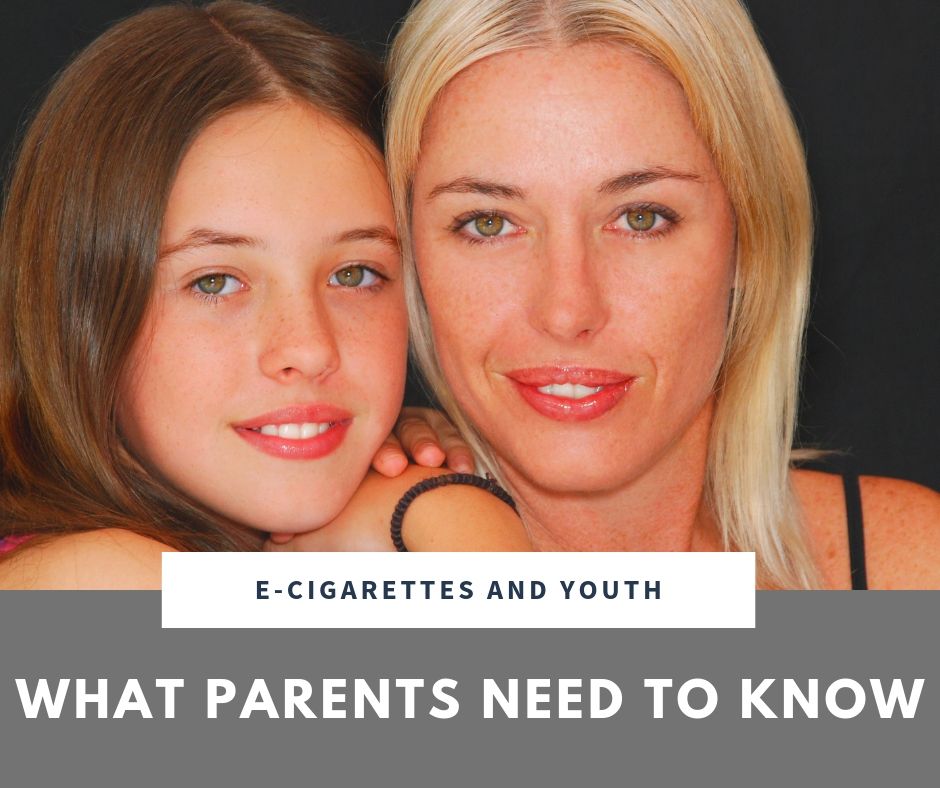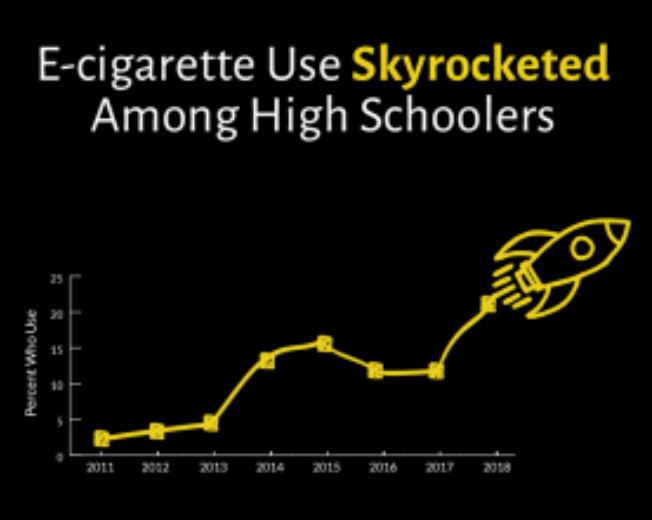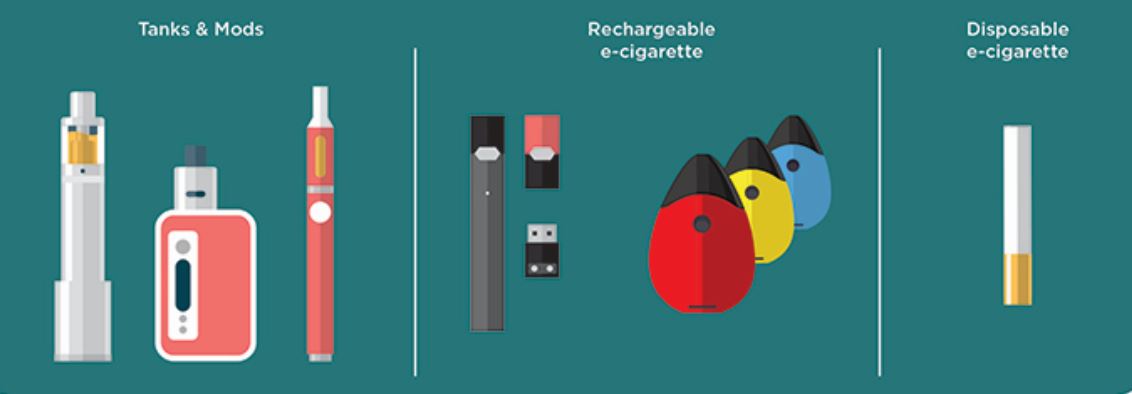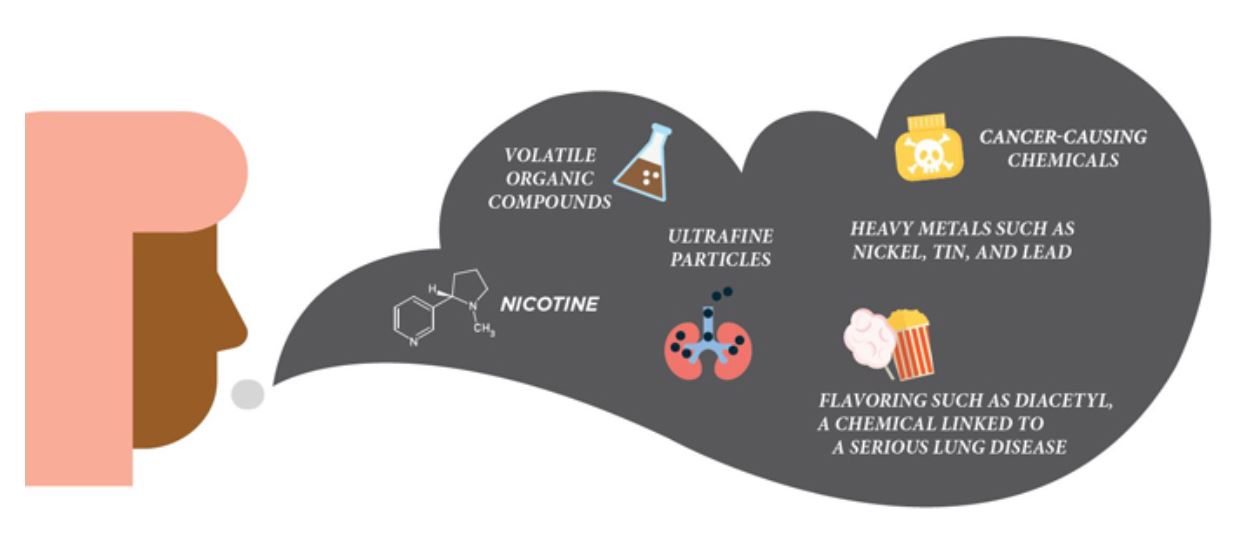
E-cigarettes and Youth: What Parents Need to Know

Electronic cigarettes (e-cigarettes) are battery-powered devices that deliver nicotine, flavorings, and other ingredients to the user. Using e-cigarettes is sometimes called “vaping.” E-cigarettes do not create harmless “water vapor” – they create an aerosol that can contain harmful chemicals.
HOW MANY YOUTH ARE USING E-CIGARETTES?
E-cigarettes have been the most commonly used tobacco product among U.S. youth since 2014. In 2018, CDC and FDA data showed that more than 3.6 million U.S. youth, including 1 in 5 high school students and 1 in 20 middle school students, were past-month e-cigarette users. During 2017 and 2018, e-cigarette use skyrocketed among youth, leading the U.S. Surgeon General to call the use of these products among youth an epidemic in the United States.

WHAT ARE THE RISKS FOR YOUTH?
Most e-cigarettes contain nicotine, which is highly addictive. Nicotine exposure during adolescence can:
- Most e-cigarettes contain nicotine—the addictive drug in regular cigarettes, cigars, and other tobacco products.
- Nicotine can harm the developing adolescent brain. The brain keeps developing until about age 25.
- Using nicotine in adolescence can harm the parts of the brain that control attention, learning, mood, and impulse control.
- Each time a new memory is created or a new skill is learned, stronger connections – or synapses – are built between brain cells. Young people’s brains build synapses faster than adult brains. Nicotine changes the way these synapses are formed.
- Each time a new memory is created or a new skill is learned, stronger connections – or synapses – are built between brain cells. Young people’s brains build synapses faster than adult brains. Nicotine changes the way these synapses are formed.
WHAT ARE THE OTHER RISKS OF E-CIGARETTE FOR KIDS, TEENS, AND YOUNG ADULTS?
Scientists are still learning about the long-term health effects of e-cigarettes. Some of the ingredients in e-cigarette aerosol could also be harmful to the lungs in the long-term. For example, some e-cigarette flavorings may be safe to eat but not to inhale because the gut can process more substances than the lungs. Defective e-cigarette batteries have caused some fires and explosions, a few of which have resulted in serious injuries. Children and adults have been poisoned by swallowing, breathing, or absorbing e-cigarette liquid through their skin or eyes.
WHAT DO E-CIGARETTES LOOK LIKE?
E-cigarettes come in many shapes and sizes. Some look like regular cigarettes, cigars, or pipes. Larger e-cigarettes such as tank systems – or “mods” – do not look like other tobacco products. Some e-cigarettes look like other items commonly used by youth, such as pens and other everyday items. New e-cigarettes shaped like USB flash drives are popular among youth, including JUUL and the PAX Era, which looks like JUUL and delivers marijuana.

WHAT IS IN E-CIGARETTE AEROSOL?
E-cigarette aerosol is NOT harmless “water vapor.” The e-cigarette aerosol that users breathe from the device and exhale can contain harmful and potentially harmful substances, including:
- Nicotine
- Ultrafine particles that can be inhaled deep into the lungs
- Flavoring such as diacetyl, a chemical linked to a serious lung disease
- Volatile organic compounds
- Cancer-causing chemicals
- Heavy metals such as nickel, tin, and lead
It is difficult for consumers to know what e-cigarette products contain. For example, some e-cigarettes marketed as containing zero percent nicotine have been found to contain nicotine.

WHAT CAN YOU DO AS A PARENT OR CAREGIVER?
- Set a good example by being tobacco-free. If you use tobacco, it’s never too late to quit.
- Start the conversation early with children about why e-cigarettes are harmful for them.
- Let your child know that you want them to stay away from all tobacco products, including e-cigarettes, because they are not safe for them. Seek help and get involved.
- Set up an appointment with your child’s health care provider so that they can hear from a medical professional about the health risks of tobacco products, including e-cigarettes.
- Speak with your child’s teacher and school administrator about enforcement of tobacco-free school grounds policies and tobacco prevention curriculum.
- Encourage your child to learn the facts and get tips for quitting tobacco products at Teen.smokefree.gov.


Most Commented